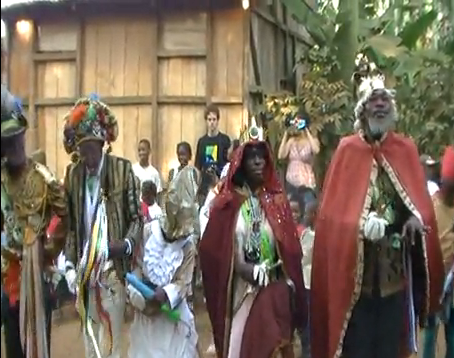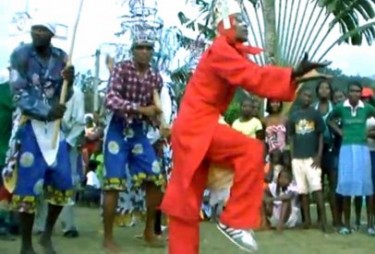The celebration of Sao Tome and Principe's 36th anniversary of independence, on July 12, involves cultural and traditional events being held throughout the country. These performances reflect the five centuries long colonial past of Sao Tome, during which many workers settled there for the production of sugar, cocoa and coffee. Moreover, having acted as “a transit point for ships engaged in the slave trade between the West and continental Africa”, the foreign influences in local traditions still persist to the present.
Though the Santomean “online stage” is still quite small, the blog Património de São Tomé (Heritage of Sao Tome), created in 2008 and only maintained during a school year of a class on Historical Heritage from a program on Tourism, has played a very important role in documenting the country's unique traditions. The coordinator of the class, teacher Marta Gomes, explained [pt] :

Tchiloli by Grupo Forrmiguinha da Boa Morte – São Tomé, August 2009. Video by Alexandra Dumas on YouTube.
São Tomé e Príncipe constitui um centro de congregação de vários povos. Como resultado desta mistura, temos a assimilação de várias tradições, costumes e culturas trazidas essencialmente pelas pessoas que vieram trabalhar nas ilhas a título de trabalho contratado.
A port of entry for cultural influences
Sao Tome has inspired many foreign artists for creations linked to the diaspora. Such is the case of the famous Capeverdean song by Cesaria Evora Sodade (Longing) and the dramatization of the Capeverdean famine of 1947 (Fome 47, by Simentera), which lead the Portuguese colonial administration to bring hundreds of people to Sao Tome. But settlers didn't come to Sao Tome only from Portuguese speaking countries. International links from many corners of the world have become part of Santomean culture itself.
One of the most original examples of foreign influences in the country – leading some to argue [it] it is the most important – is called Tchiloli. The origin of its authorship [pt] and how it was introduced [pt] in Sao Tome is uncertain: whether it “has come from France, gone through Spain, eventually making it to Portugal” or if it was written by a blind Portuguese poet from the island of Madeira called Baltazar Dias or even if it has come from Brazil, opinions differ. What is known is that Tchiloli:
is performed by prominent men of certain quarters of the island (…). The main roles are transmitted from generation to generation. Dressed in European clothes (mainly women costumes) and wearing masks, the male actors narrate a Renaissance text with music and dance, turning this spectacle into an extravagant cultural manifestation of African and European heritage.
There are collections of citizen videos and photos available online, as well as a short documentary from 1988. In this interview titled “Masks and Myths” by Inês Gonçalves e Kiluanje Liberdade (with English subtitles), one of the actors explains what it takes to be part of the cast of Tchiloli:
Danço Congo (I Dance Congo), also known as The Captain's Dance, is also one of the main cultural performances and was brought to Sao Tome and Principe from Congo by workers in the colonial time. It is thoroughly described [pt] by Angolan dancer and researcher Miriam Machado as a “frenetic, colorful, spectacular theatrical dance, with a strong – almost violent – choreography”, which can be seen in a video by Alexandra Dumas on YouTube.
Danço Congo is often staged on the celebrations of the independence day, and Miriam tells us about an interesting particularity it has:
O Danço Congo foi proibido na época colonial porque as autoridades alegavam que o seu ritmo frenético extenuava os dançarinos, diminuindo o seu rendimento no trabalho.
Another full version of the story [pt] is also published on the blog Patrimonio de Sao Tome as told by the President of the cultural group Danço Congo Mine-Carocel de Almeirim, Libiano Frota, who regrets that the tradition is “vanishing”, due to little support from the authorities responsible for the area of culture but not only:
se eu morresse agora, o Danço de Congo morreria no mesmo instante, isto porque os jovens só querem saber de jaca, safu, mangas, cartas e futebol, nada de Danço de Congo.
A call to preserve culture
On a post in Spirito Santo‘s blog describing Danço Congo as “unbelievable cultural resistance”, Helder D'ava, a Santomean citizen, commented [pt]:
É pena que em S.T.P.(terra minha), tanto por parte das autoridades como das comunidades locais, estas actuações não são reconhecidas os seus potenciais valores, o que vem resultando no seu desaparecimento a cada dia que passa.
Some solutions to “preserve the history of Sao Tome so that the future generations have a legacy worth of respect and appreciation” are pointed out [pt] by the students of the class on Historical Heritage:
os escritores deviam dedicarem-se mais à escrita da história (…) de todas as manifestações culturais;
a televisão São-tomense devia ter um espaço aberto para expor estas manifestações culturais;
o Estado devia actuar de forma mais activa e directa para a promoção destes grupos culturais.
Apelamos, também, à população em geral a respeitar os saberes e as tradições ancestrais como parte do património colectivo de uma nação, lançando campanhas de educação patrimonial, consciencializando as pessoas a valorizarem as suas tradições e o respeito pela diversidade cultural.
writers should devote themselves more to the writing of history (…) of all cultural performances;
Sao Tome television should have an open space to display these cultural expressions;
the State should act more actively and directly to the promotion of these cultural groups.
We also call for the general public to respect ancestral knowledge and traditions as part of the collective heritage of a nation by launching campaigns for education on heritage, to raise awareness of the value of people's traditions and [promote] respect for cultural diversity.









1 comment
Great work!